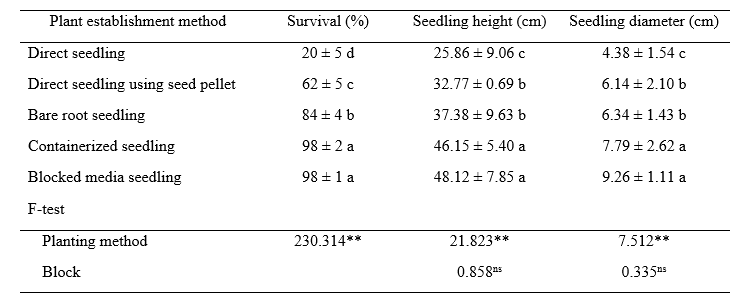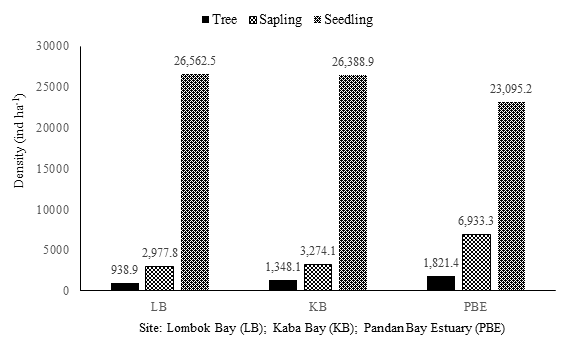Jurnal Manajemen Hutan Tropika receives the script in the form of research results (scientific articles), research notes, book review and conceptual thinking. The manuscript should be written in English.
Authors should mention the submitted type of article and a separated Microsoft Excel file of graphs used in the manuscript, and a covering letter stating concisely the importance of the article. Upon submission, Editor in Chief will assign the manuscript to a corresponding Editor for further handling. The Editor will request at least two scientists to review the manuscript. Based on the comments from the reviewers, the Editor will make the decision on the manuscript.
Submission Charge
Jurnal Manajemen Hutan Tropika does not apply any submission charge.
Processing Charge
Author whose work is accepted for publication is subjected to pay IDR1,500,000 per printed article up to 4 pages. Additional page will be charged IDR250,000 per printed page.
Within the process of scientific journal publication, rigorous editing is conducted, encompassing refinement of writing format, language, and graphical abstract presentation. The expenses associated with these services are supported through subsidies provided by JMHT.
Manuscript Format
1. Manuscript is written in 12 point Times New Roman font 1.5 space in A4 paper. Margins on all four sides are 2 cm.
2. Page numbers are located at the right top.
3. Use line numbers.
4. Figures and Tables are grouped and put at the end of the manuscript (after the References).
5. For soft copies, we accept major word processing documents. Authors should check their file for computer virus.
Additional submission
Authors should submit additional document i.e., Authors agreement declaration, Ethics and anti plagiarism statement, Disclosure statement and The authors contribution statement (in PDF file format) within manuscript.
Manuscript sections are written in the following order:
1. Title
2. Author(s) full name
3. Author(s) full address
4. Abstract
5. Keywords
6. Correspondence author data: e-mail, phone, and fax
7. Introduction
8. Methods
9. Results and Discussion
10. Conclusion
11. Recommendation (if necessary)
12. Acknowledgment (if necessary)
13. Disclosure Statement
14. References
15. Figures and the figure titles
16. Table and table titles
Detail Description of Manuscript Sections
Title Describing the contents of the principal manuscript in clear and concise way (maximum 11 words).
Author’s Data Author full name (no abbreviation), without a degree and author full address (complete with postcode). Example: Bramasto Nugroho, Department of Forest Management, Faculty of Forestry, IPB University, Academic Ring Road, Campus IPB Dramaga, Bogor, Indonesia 16680. For the correspondence author add the e-mail address, phone, and fax numbers.
Abstract Abstract is more or less 200 words words which has no reference and does not contain numbers, abbreviation, acronym or measurement unless essential. Abstract should commence with a clear introduction of 2 or 3 sentences mentioning background of the research. Subsequently, state the general problem of the research. Results are the main findings that directly answer the problem(s) of the research. Give 1 or 2 sentence(s) to discuss the finding(s) or prospective(s). Editor has the right to edit the Abstract for reason of clarity.
Keywords Consist of 4−5 phrases, first keyword being the most important (do not use word in the title).
Correspondence author Data e-mail, phone, and fax.
Introduction Contains theory, research results and latest news or the background of the importance of the research conducted, the formulation of the problem, and research purposes. Write down the background of the research and mention the previous studies that had been done. State one question(s) that are needed to answer through your work. Give a description (local and scientific name) of the studied organism.
Methods Describe in brief and concise about the research methods used include the specificity of materials and equipment, sampling (qualifications and chopped), measurement, research design, stages of the workings, parameters, and data analysis.
Results and Discussion Presenting the results obtained in brief and can be supported by the illustrations in the form of tables, figures or qualitative descriptions. The discussion is made with emphasis on cause-effect relationship, the linkage between theory and the results of previous similar studies. The author is expected to dare to assess the advantages and disadvantages of results obtained in a way to compare the results of research with the hypothesis, quality standards, and or the results of previous research or similar through the inclusion and use of primary reference in the discussion. The impact of the research conducted should be outlined at the end of the discussion.
Conclusion Describe or give an answer to the problem or research purposes, and not as a summary of research results. Conclusion made a brief, clear, qualitative, general, and is written in 1 paragraph.
Recommendation State the possible advice according to the conclusion.
Acknowledgment State the grant source (institution, year of the contract) and the person to whom the grant was given. Name the person(s) that help your work and written in a paragraph of 50 words maximum.
Disclosure Statement JMHT requires disclosure of related financial interests in publications to promote transparency. Some examples of disclosure statements can be seen in here.
References References only list the published or accepted material for publication. It should be at least 80% primary references (journal articles). Maximum use of reference derived from the reference published in the last 10 years. Bibliography contains a reference that is used in the manuscript and written in the format surname and year of publication, sorted by next letter writer's name first. Authors are strongly recommended to use any reference manager, e.g., Mendeley, EndNote, Zotero, or activating the reference add-in for Microsoft Word.
Jurnal Manajemen Hutan Tropika follows the name-year citation style. All works included in the reference section should be referred to the text. They should be referred to in the text by the name(s) of the first author and the year of publication in parentheses, using the following format: (Brower & deSalle, 1998) or Brower and deSalle (1998). Use the first author’s name and “et al.” when there are more than two authors. The order for references within parentheses in the text should be typed start from the oldest year (Monteiro & Pierce, 2001; Morinaka et al., 2002; Rubinoff & Sperling, 2002). If the references have the same year, place them alphabetically. For works by the same author(s) in the same year, append a lowercase a, b, c, etc. to the year of publication.
The reference list should follow APA styles:
Journal article
Blüthgen, N., Verhaagh, M., Goitía, W., Jaffé, K., Morawetz, W., & Barthlott, W. (2000). How plants shape the ant community in the Amazonian rainforest canopy: The key role of extrafloral nectarines and homopterans honeydew. Oecologia, 125, 229–240. https://doi.org/10.1007/s004420000449
Brancalion, P. H. S., Meli, P., Tymus, J. R. C., Lenti, F. E. B., Benini, R. M., Silva, A. P. M., ..., & Holl, K. D. (2019). What makes ecosystem restoration expensive? A systematic cost assessment of projects in Brazil. Biological Conservation, 240, 108274. https://doi.org/10.1016/j.biocon.2019.108274
Verbug, P. H., Overmars, K. P., Huigen, M. G. A., de Groot, W. T., & Veldkamp, A. (2006). Analysis of the effects of land use change on protected areas in Philippines. Applied Geography, 26, 153–173. https://doi.org/10.1016/j.apgeog.2005.11.005
Wahyudi, A. T., Takeyama, H., Okamura, Y., Fukuda, Y., & Matsunaga, T. (2003). Characterization of Aldehyde Ferredoxin Oxidoreductase-gene defective mutant in Magnetospirillum Magneticum AMB-1. Biochemical and Biophysical Research Communications, 303, 223–229. https://doi.org/10.1016/S0006-291X(03)00303-6
Books
Bukhari. (2009). Sahih Bukhari (1st ed.) (Translator: M. Muhsin Khan) (M. Al-Almany (ed.).
Dolphin, C. Z. (1994). Variables in the use of personal space in intercultural transaction. In L. A. Samovar & R. E. Porter (Eds.), Intercultural communication: A reader. California: Wadsworth, Inc.
Fricke, C., & Føllesdal, D. (Eds.). (2012). Intersubjectivity and objectivity in Adam Smith and Edmund Husserl. Berlin, Boston: De Gruyter. https://doi.org/10.1515/9783110325942
Singh, H., & Tripathi. (2007). Soil erosion and conservation. New Delhi: New Age International Publishers.
Whitmore, T. (1998). An introduction to tropical rain forests (2nd ed.). New York: Oxford University Press.
Proceeding
Yovi, E. Y., Takimoto, Y., & Matsubara, C. (2007, November 26–29). Promoting alternative physical load measurement method: Approaching % VO2 max through HR [Conference presentation]. The Agriculture Ergonomics Development Conference. Kuala Lumpur, Malaysia.
Thesis or Dissertation
Loewenstein, E. F. (1996). An analysis of the size and age structure of an uneven-aged oak forest [dissertation]. Columbia: University of Missouri.
Scoot, L. (1995). Nutritional ecology and population biology of the long-nosed bandicoot (Perameles nasuta): Implications for conservation [thesis]. Sidney: University of Sidney.
Internet Information
Covington, W. W., Niering, W. A,. Starkey, E., & Walker, J. (1999). Ecosystem restoration and management: Scientifict principles and concept. In Ecological stewardship: A common reference for ecosystem management reference (pp. 599–617). Amsterdam: Elsevier. Retrieved from: https://www.srs.fs.usda.gov/pubs/misc/misc_covington.pdf
TEMPO. (2020). Cegah covid-19, petani jahe tanami areal bekas lahan gambut terbakar. TEMPO. https://nasional.tempo.co/read/1324154/cegah-covid-19-petani-jahe-tanami-areal-bekas-lahan-gambut-terbakar
Figure Use graph in maximum width of 15 cm. Numbers and title are written in 10 point Times New Roman font.
Statistical Graph Give standard deviation to every mean value. Authors that used Microsoft Excel Program need to give the raw data.
Photo Add measurement scale if needed. Arrows should be given to point certain objects.
Table Give standard deviation to every mean value. Table titles should be concise. Explanatory material, notes on measurements, and other general information that applies to the whole table should be included as the first, unnumbered footnote and not in the table title. Numbers and table title are written in 10 point Times New Roman font.
Table 1 Comparison of nyamplung seedling growth on the several plant establishment methods


Figure 1 The comparisons of density (ind ha-1) in three location mangrove forest KNP.


